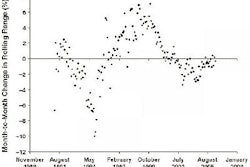The U.S. Congress adjourned over the weekend without taking action on the Deficit Reduction Act of 2005, pounding the final nail in the coffin of efforts to delay or repeal the legislation in the current legislative session. Imaging center operators are now left with figuring out how to live with the law, which on January 1, 2007 will implement a wide range of cuts to Medicare payments for outpatient imaging services.
The remaining questions will be how will the outpatient imaging center market change as a result of the DRA, and how will access to care be affected for Medicare beneficiaries. A recent report by the Moran Group suggests that a number of high-end procedures will be reimbursed at rates that are below their cost levels. In general, the report projects an average overall revenue reduction of approximately 18% for most imaging centers. This will be a very difficult reduction for outpatient imaging centers to absorb because of their high fixed-cost structure.
Regressive penalties
Within the outpatient imaging market, the DRA will function very much like a regressive tax. Regressive taxes, such as sales taxes, do not take into account the ability of the tax payer to pay the tax. If you are wealthy and have lots of cash flow, a sales tax is a nonissue. If you are living near the poverty line with limited cash flow, a sales tax is a very large issue.
For a multimodality imaging center that has made large capital outlays to have state-of-the-art technology in its facility, the DRA is similar to the regressive tax on the low-income tax payer. These centers are capable of doing the best work, but because it invested in new equipment, it is very likely that it has the lowest cash flow as a percentage of revenue. The DRA represents essentially a regressive tax for centers of this type.
On the other hand, as imaging centers mature, they complete the payment of imaging equipment leases. These centers are then able to operate without the burden of large capital outlays each month for imaging equipment. At this point in their life cycle, their financial condition improves dramatically -- adding between $30,000 and $60,000 per month to the bottom line. For these centers the impact of the DRA will be painful, but manageable.
Although their equipment leases are paid off, and cash flow and profitability are much improved, the centers are providing imaging services with equipment that is generally more than five years old. The regressive nature of the DRA will reward outpatient imaging centers that have not invested in the newest systems and will penalize imaging centers who have invested in the most current high-quality systems.
The DRA will also cause centers with higher overhead costs and loss-leader modalities to rethink their diagnostic imaging offerings. Financial executives use the phrase "addition by subtraction." This means that you can improve your profitability by eliminating services that do not add profit to your center, or those that operate at a loss.
In the past, the most profitable services have been MRI and CT. The reimbursement change for these services reduces a multimodality imaging center's capability to provide services that are marginal or unprofitable. For example, if a multimodality imaging center provides x-ray, bone densitometry, and mammography services, which for that center are not profitable services, it may be forced to discontinue them. This will reduce the access to care for patients in its service area, but will improve its profitability, as well as its capability to cope with the DRA.
A single-modality MRI center has the best opportunity to survive the DRA because it has the lowest overhead cost, outside of its equipment leases. Typically, a single-modality center leases or buys between 2,000 and 3,000 sq ft of office space for its operation, and employs between six and 12 people to provide its service. Multimodality centers range in size from 8,000 to 16,000 sq ft and can have a staff of as many as 75 people for its modalities.
If the DRA is implemented without the evaluation of its potential consequences over the next few years, the outpatient imaging market most likely will soon be comprised of facilities utilizing aging imaging equipment to provide services.
Self-referral increases
Some radiologists have posted comments on various Web sites in favor of the DRA because they believe that it will eliminate the overutilization of high-end imaging services by other medical specialties that have installed in-office imaging systems. This is a relatively short-sighted view that needs to be reconsidered.
It assumes that all specialists who install imaging equipment in their practices will increase their referral rates for imaging services by sending these studies to their equipment. This view also assumes that the regressive nature of the rule change will stifle physician office installations. The DRA would stifle these installations if the financial models for office-based installations were the same as for outpatient imaging centers; however, these two business models are really very different.
In fact, the DRA rule changes may accelerate the deployment of high-end imaging equipment into the physician office market. Neurology, cardiology, and orthopedic practices that consider these purchases are usually very large groups. When their business managers conduct imaging equipment financial analysis, it is usually based on current imaging referral rates at the time of project consideration. They usually learn that increased volume is not needed to make the project viable. Their current referral base will support the investment.
If the large nonradiology group buys its own scanner, it will have to add a very small amount of office space and a small number of employees to operate this additional service. Its current staff already includes an office manager, receptionists, billing professionals, and other necessary personnel. It will only need to add the technologists to operate the equipment. Therefore, the group can add this service to its practice for the cost of leasing about 1,500 sq ft, two or three employees, and the imaging system of choice. In addition, because the patients will come from its practice, the group will have no sales and marketing costs to bring patients into the office-based scanner.
This physician office model will be more cost-effective than the local outpatient imaging center because it will have lower overall costs per scan. Therefore, it will be profitable at lower volumes and lower reimbursement rates than the outpatient imaging centers in the same market.
The outpatient imaging centers in the markets where these vertical integrations occur will also face smaller available imaging patient pools. The office-practice model will remove those patients from normal market competition. The imaging centers will then have to compete more aggressively for the remaining business in their areas. The DRA has the potential to become a driving force to move imaging services into the office-practice market, rather than curb this trend.
Pay for performance
Over the last few years, many public policy discussions and a few proposed congressional bills have promoted pay-for-performance programs. This legislation would stimulate the market to meet well-defined quality standards. Part of the Medicare budget would be set aside to pay a premium to those organizations that consistently meet the new standards of excellence. In most cases, it is assumed that these proposals would also help to control imaging costs.
In September this year, the Institute of Medicine of the National Academies released the report "Rewarding Provider Performance: Aligning Incentives in Medicare," which outlined its position on patient-centered care and pay for performance. The report calls on Medicare to move forward with the development of a pay-for-performance program and data monitoring system that would evaluate the effectiveness of this approach. The report suggests that a pay-for-performance system would benefit patients with improved care, while also providing savings for the Medicare system.
Efforts of this type are very important to our healthcare system. We are faced with the challenge of lowering the rate of growth in healthcare expenditures, while improving the quality of the services provided as the baby-boom generation becomes Medicare eligible. This is certainly a daunting task.
The DRA, with its regressive mechanisms to control growth in spending, has the real potential of reducing the number of high-quality imaging centers that currently exist, even though they are well-positioned to compete in a pay-for-performance environment. The DRA will not stop the spread of imaging modalities into specialists' offices; it might actually accelerate this trend. It will also have the secondary effect of reducing the availability of outpatient imaging services that are not profitable, impacting the access to care for many patients.
By Ed Eichhorn
AuntMinnie.com contributing writer
December 11, 2006
Eichhorn is president of Medilink Consulting Group, a Dumont, NJ-based healthcare management consulting company focused on radiology services. The firm provides strategic planning services and value-improvement programs and can be reached at 201-384-6179 or via its Web site.
Related Reading
ACR remains optimistic as clock winds down on DRA implementation, October 24, 2006
DRA threatens to throttle PET, October 13, 2006
Study finds 87% of DRA reimbursement below procedure cost, September 19, 2006
Strategic planning considerations and the Deficit Reduction Act of 2005, June 27, 2006
DRA 2005 in practice: Where the rubber meets the road, April 27, 2006
Copyright © 2006 Medilink Consulting Group


















